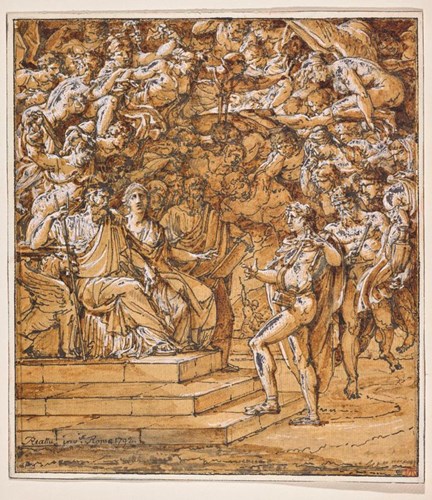Orpheus was a Thracian who excelled as a musician and singer. His music charmed wild beasts, trees, and stones. His skill with the lyre persuaded Jason to enlist his services during the voyage of the Argo, with Orpheus “singing commands to the rowers for their long-sweeping strokes”. In the fifth century BCE, many mythographers considered Homer and Hesiod as descendants of Orpheus, while both Plato and Aristophanes listed him as the most famous Greek poet. When his wife, Eurydice, died, Orpheus visited the underworld and used his music to persuade Hades to release her.

Orpheus in the Underworld; study for the painting in the Museum of Arles, Jacques Reattu, 1772, engraving, Musée du Louvre © RMN-Grand Palais (Musée du Louvre) - Michel Urtado
In the late sixth century BCE, some people in southern Italy were dissatisfied with traditional religion and assumed the name of the famous poet to produce poetry with a Pythagorean content and an eschatological orientation. These works gave a detailed description of the afterlife. Gradually, the poems circulated widely in the Greek world through books and wandering initiators.
Orpheus was not credited with any archaic epics. Despite this lack of works, by the late fifth century a number of so-called Orphic poems circulated in Athens. Their authors ranged from someone called Cercops the Pythagorean who supposedly wrote a Descent to Hades or an anonymous poet who penned a Theogony that glorified Zeus as the head and the middle and the source of everything that is fashioned. In this poem, Zeus rapes his mother Rhea-Demeter and enjoys an incestuous union in snake form with his daughter Persephone. The product of this union was Dionysus. Other poems include the famous Orphic Hymns and a poem on Demeter’s entry into Eleusis that stressed the role of Athens in the propagation of agriculture and introduced non-Eleusinian figures, such as Baubo and Eubouleus, into the myth.
These poems circulated among the higher social classes of Athens. The audience seems to have led an Orphic life, as indicated by Euripides’ Cretans, written in the early 430s with its references to vegetarianism, purity of lifestyle, and a preference for clothes of white linen. Both poems and lifestyle probably arrived in Athens with the so-called Orpheotelests, wandering initiators who exchanged their services for money. Plato mentions Orphic priestesses. The aforementioned Orphic principles isolated Orpheus’ followers from Greek religion since animal sacrifices were the central act of the latter and traditional eschatological ideas rejected reincarnation and the sense of the elect as gods.
Despite these negative connotations for the adherents, the Orphic Mysteries offered some much-needed consolation that made them popular. The concept of reincarnation provided comfort to people who felt unfairly treated in this life. The Gold Leaves (small, inscribed gold lamellae) placed in the tombs of deceased Orphics assured them that they would become gods in the afterlife and reign with the other heroes.





